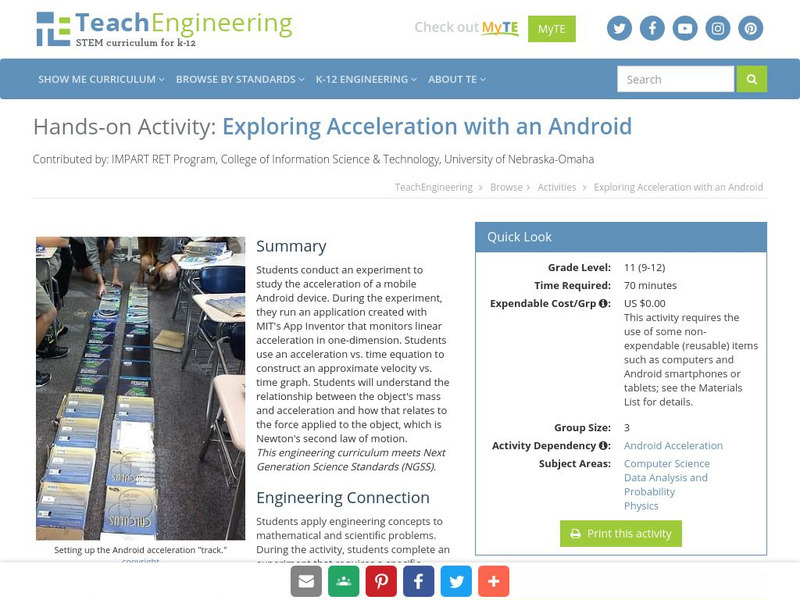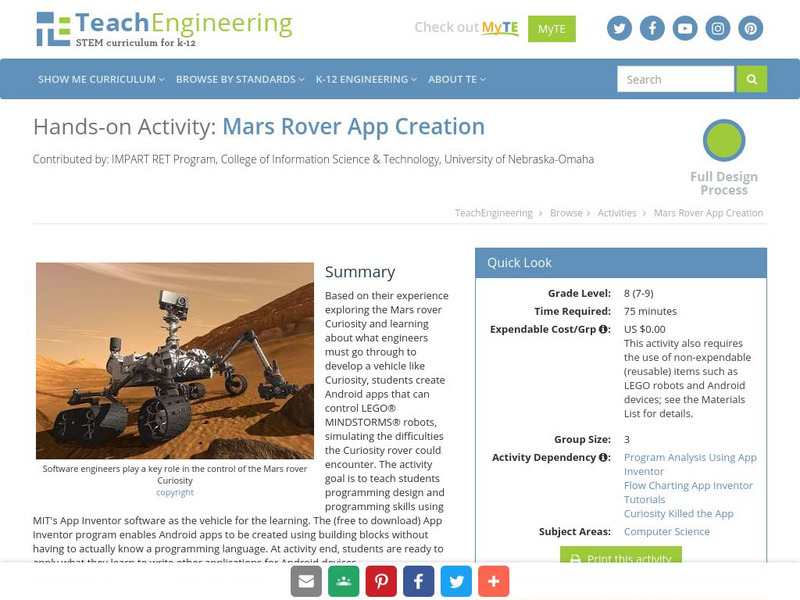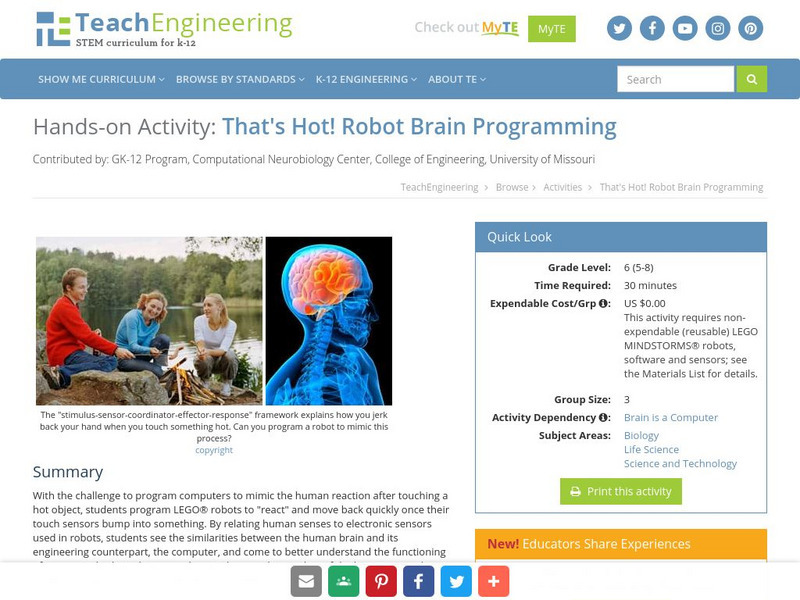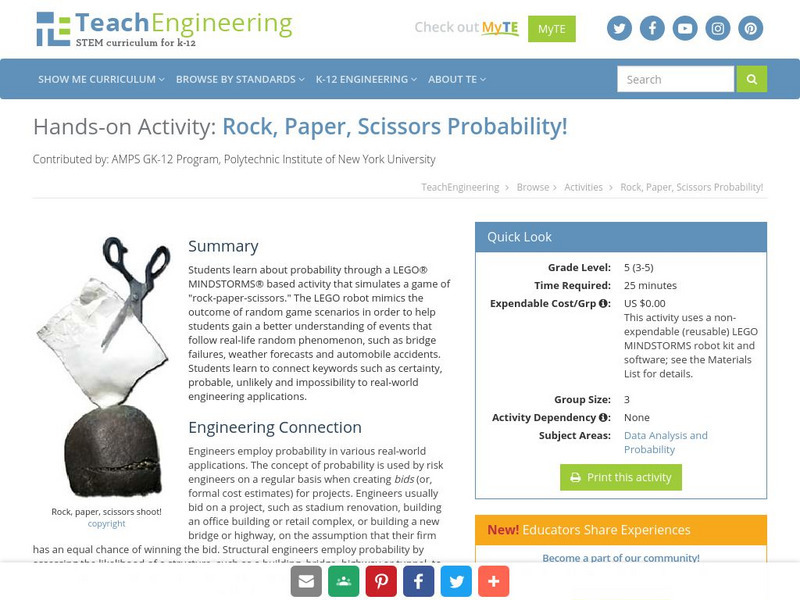Hi, what do you want to do?
Curated OER
Treated Lumber and Alternatives
Students copy the KWL chart for Treated Lumber and Alternatives. They include the provided websites. Students work with a partner to research the use of CCA lumber and its environmentally friendly substitutes. They create a PowerPoint...
Curated OER
Summer Things
In this summer things worksheet, students examine 10 pictures. Students color only those objects that you would not need during the hot summer.
Curated OER
Comparing the European Community with the U.S.
Students research a country to compare with the U.S. In this compare/contrast lesson, students research the CIA World Factbook research a European country's characteristics. Students calculate growth rate and doubling time and examine...
Curated OER
Investigation of Hooke's Law Lab
Students determine the spring constant by conducting an investigation. In this physics lesson, students collect data and create a graph of force vs. displacement. They compare the results of two different methods to find spring constant.
Curated OER
Ballistic Pendulum Lab
Students determine the muzzle velocity of projectile launcher. In this physics lesson, students compare the pendulum method and kinematic method in calculating the initial velocity. They analyze data and discuss results in class.
Curated OER
Physical Pendulum Lab
Students calculate the moment of inertia of a disc. In this physics instructional activity, students differentiate the two methods used in finding the inertia. They construct their own pendulum for the lab.
Curated OER
Rain Forests: Sustainable Use
Students discuss their opinion on a teacher given scenario. In this chemistry lesson, students research the value of rainforests. They relate these ideas to current forestry practices.
TeachEngineering
Teach Engineering: Android Acceleration Application
This unit includes two sequential lessons. In the first, students create mobile apps that collect data from an Android device's accelerometer and then store that data to a database. This lesson provides practice with MIT's App Inventor...
Science Buddies
Science Buddies: Point of a Parabola: Focusing Signals for a Better Wireless Net
Here's a project with practical applications for homes with a wireless network. This project shows you how to build and test parabolic reflectors for the transmitters on your network. You may be able to increase the range of your...
Tom Richey
Terry Freedman: The Amazing Web 2.0 Projects Book [Pdf]
This is a huge collection of ideas for using Web 2.0 technology tools in the classroom for all grade levels. The ideas were contributed by many teachers from around the world.
TeachEngineering
Teach Engineering: Curiosity Killed the App
Students gain experience with the software/system design process, closely related to the engineering design process, to solve a problem. First, they learn about the Mars Curiosity rover and its mission, including the difficulties that...
Other
Ontario Council for Technology Education: Designing Chess Pieces [Pdf]
In this project, students will design and create 3D CAD drawings of a set of chess pieces. They will work through the stages of the design process, assess and develop design criteria when creating concept and scaled sketches, and use...
Other
Ontario Council for Technology Education: Designing a Desk Organizer [Pdf]
By the end of this project, students will be able to understand and work through the stages of the design process, assess and develop design criteria when creating concept and scaled sketches, and use computer design software (SketchUp...
Other
Ontario Council for Technology Education: Designing a Bus Shelter [Pdf]
By the end of this project, the student will be able to understand and work through the stages of the design process, assess and develop design criteria when creating concept and scaled sketches, and use computer design software...
Alabama Learning Exchange
Alex: Land Surveying Project
This project resulted from of the collaboration of a computer aided drafting teacher, Chris Bond, and a math teacher, Lee Cable, (Hewitt-Trussville High School) to provide higher math expectations in CT and real life application in...
TeachEngineering
Teach Engineering: Storing Android Accelerometer Data: App Design
Students work through an online tutorial on MIT's App Inventor to learn how to create Android applications. Using those skills, they create their own applications and use them to collect data from an Android device accelerometer and...
TeachEngineering
Teach Engineering: Android App Development
Students develop an app for an Android device that utilizes its built-in internal sensors, specifically the accelerometer. The goal of this activity is to teach programming design and skills using MIT's App Inventor software (free to...
TeachEngineering
Teach Engineering: Exploring Acceleration With an Android
Students conduct an experiment to study the acceleration of a mobile Android device. During the experiment, they run an application created with MIT's App Inventor that monitors linear acceleration in one-dimension. Students use an...
TeachEngineering
Teach Engineering: Mars Rover App Creation
Based on their experience exploring the Mars rover Curiosity and learning about what engineers must go through to develop a vehicle like Curiosity, students create Android apps that can control LEGO MINDSTORMS NXT robots, simulating the...
TeachEngineering
Teach Engineering: That's Hot! Robot Brain Programming
With the challenge to program computers to mimic the human reaction after touching a hot object, students program LEGO robots to "react" and move back quickly once their touch sensors bump into something. By relating human senses to...
TeachEngineering
Teach Engineering: Digital Mapping and Geographic Information Systems (Gis)
Geographic information systems (GIS), once used predominantly by experts in cartography and computer programming, have become pervasive in everyday business and consumer use. This unit explores GIS in general as a technology about which...
TeachEngineering
Teach Engineering: Haptics: Touch Command
Students experience haptic (the sense of touch) feedback by using LEGO MINDSTORMS NXT robots and touch sensors to emulate touch feedback recognition. With four touch sensors connected to LEGO NXTs, they design sensor attachments that...
TeachEngineering
Teach Engineering: Robotic Perimeter
Students learn and practice how to find the perimeter of a polygonal shape. Using a ruler, they measure model rooms made of construction paper walls. They learn about other tools, such as a robot, that can help them take measurements....
TeachEngineering
Teach Engineering: Rock, Paper, Scissors Probability!
Students learn about probability through a LEGO MINDSTORMS NTX-based activity that simulates a game of "rock-paper-scissors." The LEGO robot mimics the outcome of random game scenarios in order to help students gain a better...












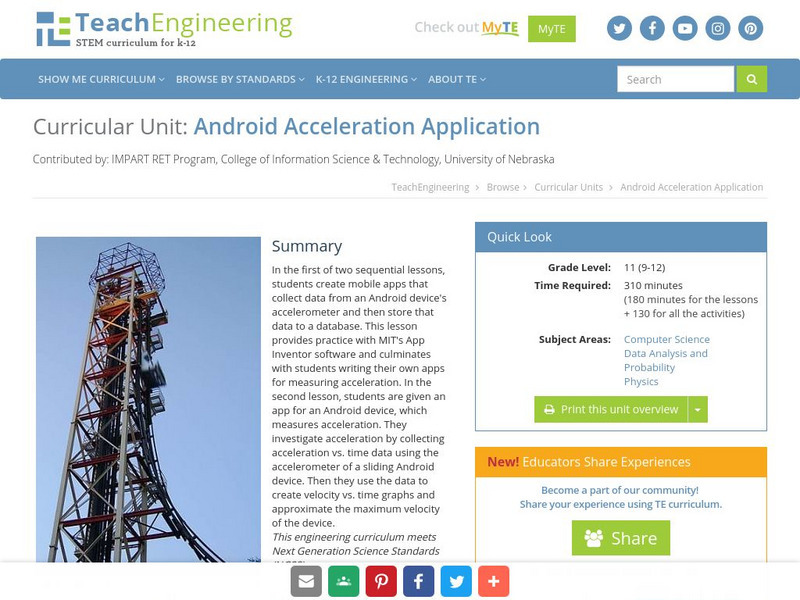

![Terry Freedman: The Amazing Web 2.0 Projects Book [Pdf] Website Terry Freedman: The Amazing Web 2.0 Projects Book [Pdf] Website](https://content.lessonplanet.com/knovation/original/362183-6256063a5e308c1c6e73c8fae808d290.jpg?1661183836)

![Ontario Council for Technology Education: Designing Chess Pieces [Pdf] Lesson Plan Ontario Council for Technology Education: Designing Chess Pieces [Pdf] Lesson Plan](https://static.lp.lexp.cloud/images/attachment_defaults/resource/large/FPO-knovation.png)



